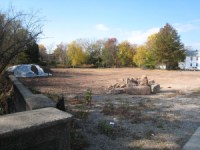Two months after rejecting bids for the amphitheater parking lot project, the Redevelopment Agency awarded a $1.1-million contract to Gingerelli Bros at its meeting earlier this month. Berto Construction submitted a bid of $1.6 million. Bids were received July 29.
 A pre-construction meeting is scheduled for next week, City Engineer James Housten said, after which construction should begin, including work on drainage, stream bank stabilization, curbing and lighting foundations. Work is expected to be completed in conjunction with renovations of the Hamilton Stage, which is expecting to be finished in the spring. Toms River-based Gingerelli Bros. also is the firm that was awarded the $5.825-million contract for the Hamilton Stage.
A pre-construction meeting is scheduled for next week, City Engineer James Housten said, after which construction should begin, including work on drainage, stream bank stabilization, curbing and lighting foundations. Work is expected to be completed in conjunction with renovations of the Hamilton Stage, which is expecting to be finished in the spring. Toms River-based Gingerelli Bros. also is the firm that was awarded the $5.825-million contract for the Hamilton Stage.
The Redevelopment Agency early this year decided to delay building the amphitheater and instead build about 115 parking spaces in the interim.
The center stairs of the inbound platform of Rahway Train Station finally opened today, approximately 18 months after they were closed for repairs. 18 months. NJ Transit also issued an advisory this week that as part of repairs to the elevator on the outbound platform (which are expected to last until early next month), travelers will not be able to use the sidewalk to the corner of Milton Avenue and Broad Street from Monday to Thursday of next week due to the installation of a pump and tank next to the pedestrian tunnel.






